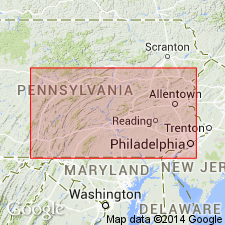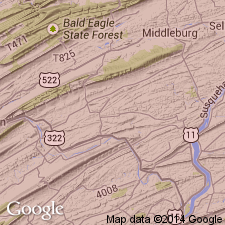
- Usage in publication:
-
- Dauphin shale
- Modifications:
-
- Named
- Dominant lithology:
-
- Shale
- AAPG geologic province:
-
- Appalachian basin
Summary:
Named the Dauphin shale of the Martinsburg group in PA for Dauphin Co., south-central and east central Pennsylvania. Unit is the lower shaly part of Martinsburg group. Overlies Chambersburg limestone or Jacksonburg limestone and underlies Fairview sandstone or Shochary sandstone. The Dauphin is of Middle Ordovician age.
Source: GNU records (USGS DDS-6; Reston GNULEX).

- Usage in publication:
-
- Dauphin shale
- Modifications:
-
- Areal extent
- AAPG geologic province:
-
- Appalachian basin
Summary:
Geographically extended the Dauphin shale to northwestern NJ. Unit is mostly black shale west of Delaware Valley and black slate in Delaware Valley. Thickness is at least 3,500 feet.
Source: GNU records (USGS DDS-6; Reston GNULEX).
For more information, please contact Nancy Stamm, Geologic Names Committee Secretary.
Asterisk (*) indicates published by U.S. Geological Survey authors.
"No current usage" (†) implies that a name has been abandoned or has fallen into disuse. Former usage and, if known, replacement name given in parentheses ( ).
Slash (/) indicates name conflicts with nomenclatural guidelines (CSN, 1933; ACSN, 1961, 1970; NACSN, 1983, 2005, 2021). May be explained within brackets ([ ]).

